Abstract
This article presents the bending analysis of an inhomogeneous composite sandwich rectangular plate with viscoelastic core. The sinusoidal plate theory as well as other familiar shear deformation plate theories is used. Different types of intermediate plates are considered according to the thickness of all layers and the symmetry of the plate. Illyushin's approximation and the effective moduli methods are used to treat the governing equations of sandwich plates that reinforced with inhomogeneous fibers. Various results for deflections of and some stresses in such plates are presented. A comparison study is made to investigate the effect of time, inhomogeneity, and constitutive parameters as well as the effect of span-to-thickness and aspect ratios on the bending response of the sandwich plates.
1. Introduction
Sandwich structure is widely used in modern applications, especially in civil, marine and mechanical engineering industries due to its light weight and high rigidity. Sandwich plates are basically a special form of fiber-reinforced rectangular plates composed of alternative arrangement of thin stiff layers and thick flexible cores. They also made up of two thin strong, stiff face layers which resist bending bonded to a relatively thicker, less dense core layer to resist shear force. There has recently been a great interest to study the behavior of sandwich structures subjected to static or dynamic loads [1-4]. Whitney [5] and Vinson [6] have discussed the structure of sandwich plates and emphasized the importance of including shear flexibility of their cores. Pagano [7] and Pagano and Hatfield [8] have presented exact 3-D elasticity solutions for the stresses in the composite laminates and sandwich plates. In fact, Zenkour [9] has presented recent results more general than the well-known of Pagano [7] and Pagano and Hatfield [8] and they served as benchmark solutions for other researchers. Zenkour and his colleagues [10-15] have presented a 2-D solution for the bending and/or free vibration of functionally graded (FG) sandwich rectangular plates. They have investigated the thermo-mechanical bending analysis of FG sandwich plates. In addition, they have presented much elastic foundation analyses of uniformly loaded FG viscoelastic sandwich plates.
The classical plate theory (CPT) gives inaccurate results for thick or may be moderately thick rectangular plates because it ignores transverse shear effects. However, it provides reasonable results for thin plates. The first-order shear deformation plate theory (FPT) [16] is an improvement on the CPT. It accounts for transverse shear effects but needs a shear correction factor to give reasonable results. Higher-order shear deformation plate theory (HPT) [17] can represent the kinematics behavior of most laminated plates better. It does not require shear correction factors and can be used to compute inter-laminar stresses more accurately.
In this article, the sinusoidal shear deformation theory of plate (SPT) [18] as well as other familiar plate theories (CPT, FPT and HPT) is used to study the static bending of a viscoelastic rectangular sandwich plate. The faces of this sandwich plate made of the same elastic isotropic material while its core is made of a viscoelastic one. With the help of Illyushin approximation method [19], and the effective-moduli method [20], a wide range of deflections and stresses is presented to the bending of sandwich plates. A comparison between the various theories of plates is investigated. Additional results for the bending of fiber-reinforced inhomogeneous viscoelastic sandwich plates are added to serve as benchmarks for future comparisons with other researchers.
2. Basic equations
Let us consider a symmetric sandwich plate of uniform thickness , length , and width and composed of three inhomogeneous layers (see Fig. 1). To describe infinitesimal deformations of the three-layer sandwich plate one can used the Cartesian coordinates . The plane represents the mid-plane of the plate while represent its external bounding planes. The upper surface is subjected to a normal traction , while its lower surface is traction free. Different types of symmetric sandwich plate are considered according to the thickness of the core and faces. For example, the (1-5-1) sandwich plate is given when the core thickness of the plate is equal to five times the face thickness, i.e., and . In the (2-1-2) sandwich plate, the core thickness is half the face thickness, i.e., and . The (1-1-1) sandwich plate is made of three layers with equal thickness, i.e., and . Also, the coreless sandwich plate (1-0-1) is considered with two face layers of equal thickness, i.e., .
Fig. 1Coordinates and geometry for the viscoelastic sandwich plate
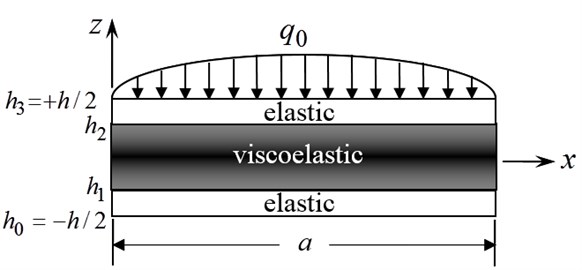
The material properties of the inhomogeneous layers are smoothly varying in the thickness -direction only. That is:
where is the inhomogeneity parameter and are the transformation elastic coefficients that depending on the material properties of the homogeneous th layer:
in which is Young’s modulus of layer and is its Poisson’s ratio. The displacement field of a point at in the plate may be written as [18]:
where are functions of the spatial co-ordinate that represent the displacements corresponding to the co-ordinate system; are the displacements along the axes , and , respectively, and and are the rotations about the - and -axes. The generalized displacements are functions of and . The shape function may be chosen such that:
The first condition in Eq. (4) means that the transverse shear strain vanishes on the bounding planes . The shear deformation theory that satisfies this condition dose not requires any shear-correction factors. In general, the second condition in Eq. (4) may be satisfied for most two-dimensional theories. In more details, there is no shape function for CPT, i.e. while for FPT, for HPT, and for SPT [20].
The strain-displacement relations are given by:
where:
Each layer of the present sandwich plate may be treated as an individual inhomogeneous plate. So, the stress-strain relations for the th layer, according to the inclusion of the transverse shear deformation, can be expressed as:
The principle of virtual displacement may be expressed for this case as:
or:
where are the stress resultants, are the stress couples, are the transverse shear stress resultants, and are stress couples added to associate with the transverse shear effects:
in which and are the bottom and top -coordinates of the layer .
3. Governing equations
Eq. (8) is used to obtain the governing equilibrium equations by integrating the displacement gradient in by parts and setting the coefficients of to zero separately. In this case, we get:
Substituting Eq. (7) into Eq. (10), the resultants , , and can be represented in terms of the total strains:
where:
The stiffness coefficients , , … etc., are defined as:
where and represent the shear correction factors for FPT only. Their suitable values for FPT are . Otherwise, they should be unity.
4. Closed-form solution
The closed-form solution of Eq. (11) for the sandwich plate may be obtained here. The simply-supported boundary conditions at the side edges are imposed as follows:
To solve the present problem, the external force is represented according to Navier-type in the form of a sinusoidally distributed load as:
where and . The plate-center intensity of the load is denoted by . In addition, one can assume the following solution forms for that satisfies the boundary conditions:
where are arbitrary parameters to be determined. Substituting Eqs. (16) and (17) into Eq. (11), one obtains:
where and denote the columns:
where “” denotes the vector transpose of and . The elements of the coefficient matrix are given by:
The stress components may be obtained by substituting Eq. (17) into Eq. (6). They are appeared in terms of the arbitrary parameters and the material properties as:
5. Viscoelastic solution
In this problem, the core is made of a viscoelastic isotropic material while the face sheets are made of an isotropic material with and . However, the viscoelastic properties are given by:
where is the bulk modulus (the coefficient of volume compression) and is the dimensionless kernel of relaxation function. It is assumed that is not relaxed, i.e. constant.
Firstly, the corresponding elastic problem is solved numerically for variable values of . Then, one can use the realization method of elastic solution for solving the problem of quasi-static linear viscoelastic composite. In the elastic case are functions of , and while in the viscoelastic case, they are operator functions of , and time . According to Illyushin’s approximation method (see Pobedrya [19]), the displacement functions can be represented for layer in the form:
where are five known kernels. They constructed on the basis of and one can choose them in the form:
where , . The coefficients may be determined from the following algebraic equations system:
where:
The viscoelastic solution can now record to get explicit unified form for the displacements as:
Taking where is the Heaviside’s unit step function:
then, Eq. (27) for the two problems takes the form:
where , , and .
Assuming an exponential relaxation function:
where and are constants, and is the relaxation time. The functions and can be determined by deducing their Laplace-Carson transforms from the known ones of [21, 22]. They take the following forms:
where:
So, the displacements are given in the final form, in terms of the time or the time parameter , by:
Once again, the same technique is used to obtain the stresses by replacing only with . So, the bending stresses in terms of the time or the time parameter are given by:
6. Numerical examples and discussions
Numerical examples are obtained for the deflections of and stresses in viscoelastic sandwich plates. The relaxation time is still unknown and the time parameter is given in terms of it. The constitutive parameter is given by . In addition, it is assumed, unless otherwise stated, that , , , , , , and .
The following dimensionless quantities are used throughout the calculations (:
Table 1 contains the dimensionless deflections of inhomogeneous (1-5-1) viscoelastic sandwich plates. The effect of the side-to-thickness ratio , the constitutive parameter , and the aspect ratio is presented. The results show that the dimensionless deflection increases as the side-to-thickness ratio and aspect ratio increase while it decreases as the constitutive parameter increases. The HPT yields results closer than FPT to those obtained using SPT. The CPT failed to give reliable results for thicker plates .
Table 1Effects of the constitutive parameter ζ, side-to-thickness ratio a/h, and aspect ratio b/a on the dimensionless deflection w of the (1-5-1) sandwich plate
SPT | HPT | FPT | CPT | SPT | HPT | FPT | CPT | ||
5 | 0.5 1.0 1.5 2.0 | 0.11835 0.63719 1.18499 1.56521 | 0.11810 0.63650 1.18403 1.56409 | 0.11352 0.62479 1.16774 1.54524 | 0.09093 0.56831 1.08955 1.45488 | 0.06963 0.35665 0.65556 0.86217 | 0.06945 0.35609 0.65476 0.86123 | 0.06175 0.33647 0.62749 0.82968 | 0.04856 0.30348 0.58181 0.77690 |
10 | 0.5 1.0 1.5 2.0 | 0.19565 1.17115 2.22690 2.96501 | 0.19551 1.17079 2.22641 2.96444 | 0.19315 1.16486 2.21819 2.95495 | 0.18186 1.13663 2.17910 2.90977 | 0.10777 0.63366 1.20062 1.59656 | 0.10765 0.63336 1.20020 1.59606 | 0.10371 0.62345 1.18646 1.58019 | 0.09711 0.60695 1.16363 1.55380 |
20 | 0.5 1.0 1.5 2.0 | 0.37063 2.29053 4.38211 5.84717 | 0.37055 2.29034 4.38186 5.84688 | 0.36937 2.28737 4.37774 5.84212 | 0.36372 2.27326 4.35820 5.81954 | 0.19957 1.22728 2.34577 3.12899 | 0.19951 1.22712 2.34555 3.12874 | 0.19752 1.22215 2.33867 3.12080 | 0.19423 1.21391 2.32725 3.10760 |
Tables 2-4 contain the stresses in the inhomogeneous (1-5-1) viscoelastic sandwich plates at different values of side-to-thickness ratio , constitutive parameter and aspect ratio , respectively. The results given in Table 2 show that the stresses, except , increase as the side-to-thickness ratio increases. Table 3 shows that the stresses and increase with the increase of while the rest of stresses are decreasing. Table 4 shows that the stresses increase with the increase of the aspect ratio . In these figures, CPT gives similar results as FPT and may be ignore. Once again, HPT yields results closer than FPT to those obtained using SPT.
Figs. 2 and 3 illustrate the transverse shear stresses and through-the-thickness of the (1-5-1) sandwich plate using various theories. It can be seen that the shear stresses take larger values at the core (viscoelastic) layer and the HPT yields results very close to those obtained using SPT. The FPT gives non-zero shear stresses at the top and bottom surfaces of the plate. Also, the SPT gives accurate results, especially transverse shear stresses, compared with other theories including HPT. This is an expected because SPT is the generalized one.
Table 2Dimensionless stresses versus the side-to-thickness ratio a/h in the (1-5-1) sandwich plate
Theory | ||||||
5 | SPT HPT FPT CPT | 0.31925 0.31911 0.31687 0.31687 | 0.13877 0.13892 0.14008 0.14008 | 0.31451 0.31397 0.30691 0.30691 | 0.11605 0.11124 0.06777 – | 0.34816 0.33373 0.20332 – |
10 | SPT HPT FPT CPT | 0.63494 0.63487 0.63374 0.63374 | 0.13975 0.13979 0.14008 0.14008 | 0.30881 0.30868 0.30691 0.30691 | 0.11627 0.11141 0.06777 – | 0.34881 0.33422 0.20332 – |
20 | SPT HPT FPT CPT | 1.26809 1.26805 1.26749 1.26749 | 0.14000 0.14001 0.14008 0.14008 | 0.30738 0.30735 0.30691 0.30691 | 0.11632 0.11145 0.06777 – | 0.34897 0.33435 0.20332 – |
50 | SPT HPT FPT CPT | 3.16896 3.16895 3.16872 3.16872 | 0.14007 0.14007 0.14008 0.14008 | 0.30698 0.30698 0.30691 0.30691 | 0.11634 0.11146 0.06777 – | 0.34901 0.33438 0.20332 – |
Table 3Dimensionless stresses versus the constitutive parameter ζ in the (1-5-1) sandwich plate
Theory | ||||||
0.1 | SPT HPT FPT CPT | 0.38591 0.38585 0.38506 0.38506 | 0.16619 0.16622 0.16646 0.16646 | 0.21512 0.21503 0.21391 0.21391 | 0.12355 0.11850 0.07983 – | 0.37064 0.35550 0.23950 – |
0.2 | SPT HPT FPT CPT | 0.63494 0.63487 0.63374 0.63374 | 0.13975 0.13979 0.14008 0.14008 | 0.30881 0.30868 0.30691 0.30691 | 0.11627 0.11141 0.06777 – | 0.34881 0.33422 0.20332 – |
0.3 | SPT HPT FPT CPT | 0.83231 0.83224 0.83092 0.83092 | 0.12403 0.12407 0.12439 0.12439 | 0.36241 0.36225 0.35999 0.35999 | 0.11143 0.10651 0.05888 – | 0.33428 0.31952 0.17664 – |
0.5 | SPT HPT FPT CPT | 1.15235 1.15228 1.15069 1.15069 | 0.10514 0.10519 0.10552 0.10552 | 0.42327 0.42305 0.41999 0.41999 | 0.10465 0.09939 0.04664 – | 0.31395 0.29818 0.13991 – |
0.9 | SPT HPT FPT CPT | 1.64104 1.64097 1.63904 1.63904 | 0.08498 0.08502 0.08535 0.08535 | 0.48200 0.48165 0.47734 0.47734 | 0.09541 0.08939 0.03294 – | 0.28622 0.26817 0.09882 – |
In Figs. 4 and 5, the SPT is used to plot the shear stresses and through-the-thickness of different kinds of the sandwich plates. It is seen that, both of and take different behaviors according to the thickness of the core layer compared with the thickness of the other faces. If there is no core as in the case of (1-0-1) plate, this means that the plate becomes fully elastic and the shear stresses take the same curve-related shape with maximum points near the lower faces. For other sandwich plates, the maximum values of the shear stresses occur at the first interface. The values of may be three times those of .
Table 4Dimensionless stresses versus the aspect ratio b/a in the (1-5-1) sandwich plate
Theory | ||||||
0.1 | SPT HPT FPT CPT | 0.06719 0.06716 0.06663 0.06663 | 0.05617 0.05623 0.05677 0.05677 | 0.09347 0.09329 0.09094 0.09094 | 0.15469 0.14829 0.09037 – | 0.07735 0.07414 0.04518 – |
0.2 | SPT HPT FPT CPT | 0.24691 0.24686 0.24608 0.24608 | 0.11396 0.11402 0.11445 0.11445 | 0.28734 0.28712 0.28417 0.28417 | 0.19369 0.18561 0.11296 – | 0.19369 0.18561 0.11296 – |
0.3 | SPT HPT FPT CPT | 0.41229 0.41223 0.41129 0.41129 | 0.13368 0.13372 0.13409 0.13409 | 0.36613 0.36593 0.36321 0.36321 | 0.17884 0.17137 0.10427 – | 0.26826 0.25706 0.15640 – |
0.5 | SPT HPT FPT CPT | 0.52203 0.52197 0.52093 0.52093 | 0.13880 0.13884 0.13917 0.13917 | 0.36628 0.36610 0.36374 0.36374 | 0.15501 0.14854 0.09037 – | 0.31003 0.29707 0.18073 – |
0.9 | SPT HPT FPT CPT | 0.59086 0.59079 0.58970 0.58970 | 0.13982 0.13986 0.14017 0.14017 | 0.34009 0.33993 0.33790 0.33790 | 0.13364 0.12805 0.07790 – | 0.33410 0.32013 0.19475 – |
Fig. 2Distribution of σ4 through-the-thickness of the (1-5-1) sandwich plate
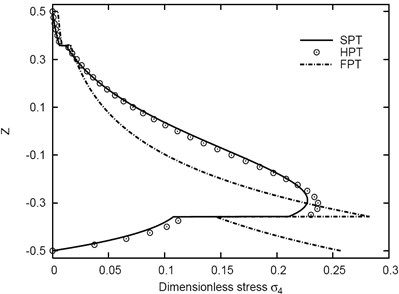
Fig. 3Distribution of σ5 through-the-thickness of the (1-5-1) sandwich plate
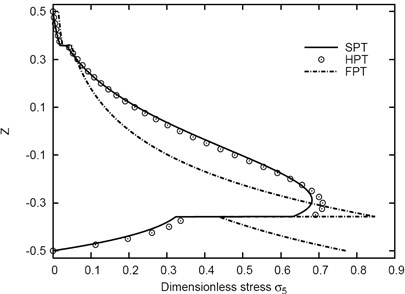
Figs. 6-8 plot the deflection vs the time parameter of the inhomogeneous (1-5-1) sandwich plate using various theories for different values of aspect ratio , side-to-thickness ratio , and the constitutive parameter , respectively. It is seen that increases as and increase and decreases as increases (see also Table 1). In addition, increases to get its local maximum at , then it decreases to get its local minimum at . After that the deflection is directly increasing as the time parameter increases and become constant at .
Fig. 9 illustrates the variation of vs the time parameter for different types of inhomogeneous viscoelastic sandwich plates. It can be seen that, the deflection increases with the decrease of the thickness of the core compared with the thickness of the two faces. The deflection becomes constant in the case of the (1-0-1) fully elastic plate. This is expected since there is no viscoelastic fore for this plate. Finally, Figs. 10-12 illustrate the variation of in-plane stresses , , and vs for different values of thickness of the (1-5-1) sandwich plates. The variations of stresses are appears clearly with the variation of the time parameter and becomes constant for .
Fig. 4Distribution of σ4 through-the-thickness of different sandwich plates
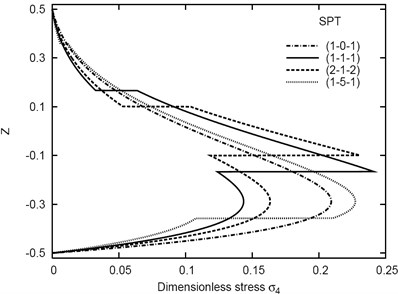
Fig. 5Distribution of σ5 through-the-thickness of different sandwich plates
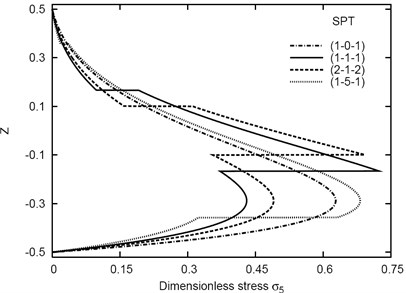
Fig. 6Variation of w vs τ for different b/a of the (1-5-1) sandwich plate
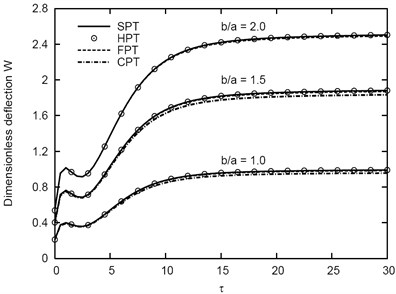
Fig. 7Variation of w vs τ for different a/h of the (1-5-1) sandwich plate
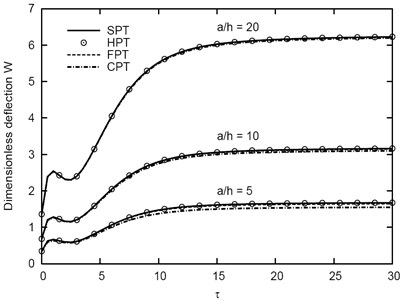
Fig. 8Variation of w vs τ for different ζ of the (1-5-1) sandwich plate
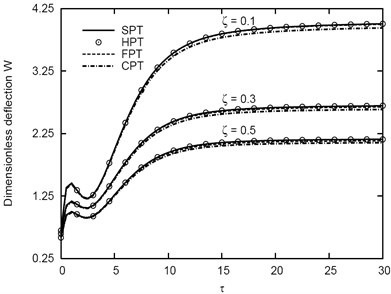
Fig. 9Variation of w vs τ for different sandwich plates
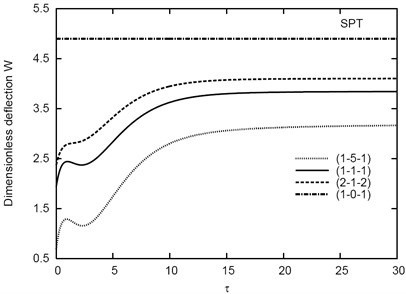
7. Conclusions
Bending response of inhomogeneous viscoelastic sandwich plates is investigated by using various plate theories. The governing equations of the sinusoidal (SPT), higher-order (HPT), first-order (FPT) and classical (CPT) plate theories are converted into a single system of equations. Analytical solutions are developed using the Navier’s procedure and separation of variable technique. The results of SPT are compared with those obtained by HPT, FPT and CPT. The SPT and HPT contain the same number of dependent variables as in FPT, but results are more accurate prediction of deflections and stresses, and satisfy the zero tangential traction boundary conditions on the surfaces of the plate. However, both SPT and HPT do not require the use of shear correction factors. Numerical computations were carried out to study the effect of time parameter on deflections and stresses at different values of aspect ratio , side-to-thickness ratio and constitutive parameter . The obtained results show how the dimensionless stresses and deflection affected with the elastic properties of the layers. It is to be noted that, the variation of dimensionless stresses and deflection versus the time parameter has the high sensitivity at viscoelastic layer. The CPT yields identical stresses with the FPT. In conclusion, the HPT yields results very close to those obtained using SPT which gives accurate results, especially transverse shear stresses, than other theories including HPT.
Fig. 10Variation of σ1 vs τ for different Z in the (1-5-1) sandwich plate
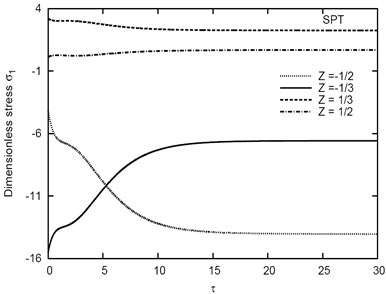
Fig. 11Variation of σ2 vs τ for different Z in the (1-5-1) sandwich plate
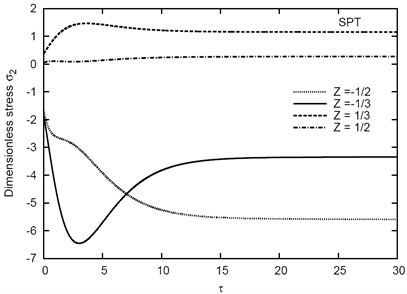
Fig. 12Variation of σ6 vs τ for different Z in the (1-5-1) sandwich plate
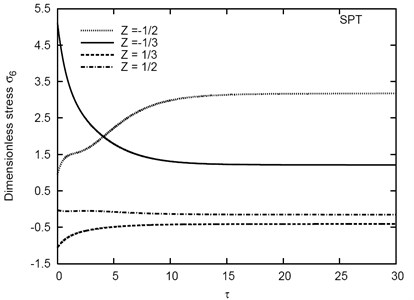
References
-
Plantema F. J. Sandwich Construction: The Bending and Buckling of Sandwich Beam, Plates and Shells. Wiley, New York, 1966.
-
Allen H. G. Analysis and Design of Structural Sandwich Panels. Pergamon Press, Oxford, 1969.
-
Zenkert D. An Introduction to Sandwich Construction. Chameleon Press Ltd, London, 1995.
-
Noor A. K., Burton W. S., Bert C. W. Computational models for sandwich panels and shells. Journal of Applied Mechanics, Vol. 49, 1996, p. 155-199.
-
Whitney J. M. Structural Analysis of Laminated Anisotropic Plates. Technomic, Lancaster, PA, 1987.
-
Vinson J. R. The Behavior of Sandwich Structures of Isotropic and Composite Materials. Technomic, Lancaster, PA, 1999.
-
Pagano N. J. Exact solutions for rectangular bidirectional composite and sandwich plates. Journal of Composite Materials, Vol. 4, 1970, p. 20-34.
-
Pagano N. J., Hatfield S. J. Elastic behaviour of multilayered bidirectional composite. AIAA Journal, Vol. 10, 1972, p. 931-933.
-
Zenkour A. M. Three-dimensional elasticity solution for uniformly loaded cross-ply laminates and sandwich plates. Journal of Sandwich Structures and Materials, Vol. 9, 2007, p. 213-238.
-
Zenkour A. M. A comprehensive analysis of functionally graded sandwich plates: part 1 – deflection and stresses. International Journal of Solids and Structures, Vol. 42, 2005, p. 5224-5242.
-
Zenkour A. M. A comprehensive analysis of functionally graded sandwich plates: part 2 – buckling and free vibration. International Journal of Solids and Structures, Vol. 42, 2005, p. 5243-5258.
-
Zenkour A. M., Alghamdi N. A. Thermoelastic bending analysis of functionally graded sandwich plates. Journal of Material Sciences, Vol. 43, 2008, p. 2574-2589.
-
Zenkour A. M., Alghamdi N. A. Thermomechanical bending response of functionally graded nonsymmetric sandwich plates. Journal of Sandwich Structures and Materials, Vol. 12, 2010, p. 7-46.
-
Allam M. N. M., Zenkour A. M., El-Mekawy H. F. Bending response of inhomogeneous fiber-reinforced viscoelastic sandwich plates. Acta Mechanica, Vol. 209, 2010, p. 231-248.
-
Zenkour A. M., Sobhy M. Elastic foundation analysis of uniformly loaded functionally graded viscoelastic sandwich plates. Journal of Mechanics, Vol. 28, 2012, p. 439-452.
-
Reissner E. On bending of elastic plates. Quarterly of Applied Mathematics, Vol. 5, 1947, p. 55-68.
-
Reddy J. N. A simple higher-order theory for laminated composite plates. Journal Applied Mechanics, Vol. 51, 1984, p. 745-752.
-
Zenkour A. M. Generalized shear deformation theory for bending analysis of functionally graded plates. Applied Mathematical Modelling, Vol. 30, 2006, p. 67-84.
-
Illyushin A., Pobedria B. E. Foundations of Mathematical Theory of Thermo Viscoelasticity. Moscow, Nauka, 1970.
-
Pobedrya E. Structural anisotropy in viscoelasticity. Polymer Mechanics, Vol. 12, 1976, p. 557-561.
-
Zenkour A. M. Thermal effects on the bending response of fiber-reinforced viscoelastic composite plates using a sinusoidal shear deformation theory. Acta Mechanics, Vol. 171, 2004, p. 171-187.
-
Zenkour A. M. Buckling of fiber-reinforced viscoelastic composite plates using various plate theories. Journal of Engineering Mathematics, Vol. 50, 2004, p. 75-93.
About this article
This work was funded by the Deanship of Scientific Research (DSR), King Abdulaziz University, Jeddah. The authors, therefore, acknowledge with thanks the DSR technical and financial support.
